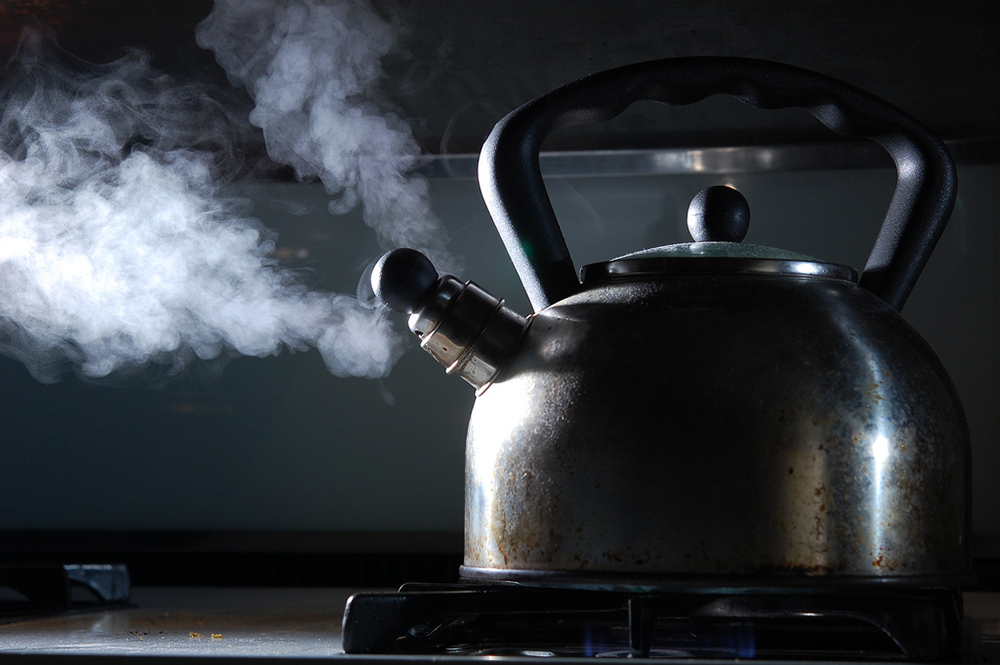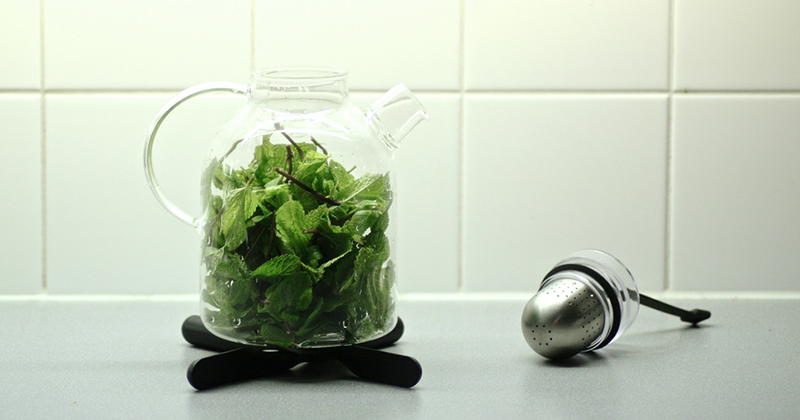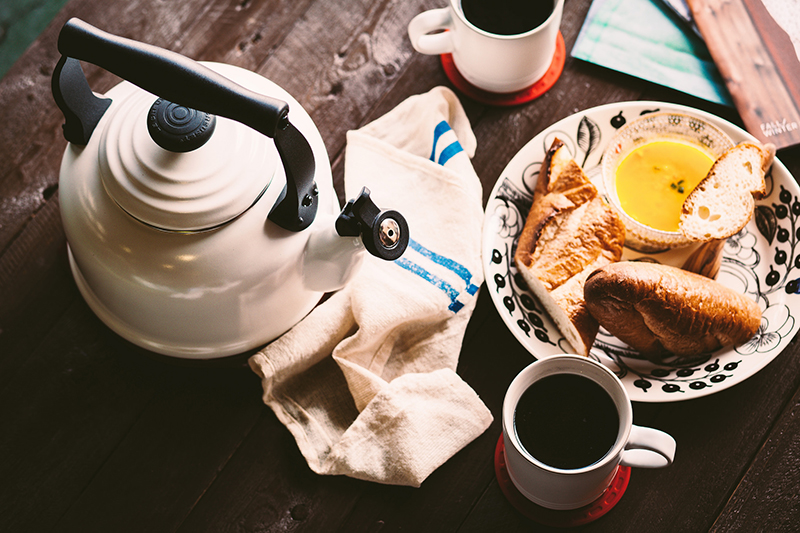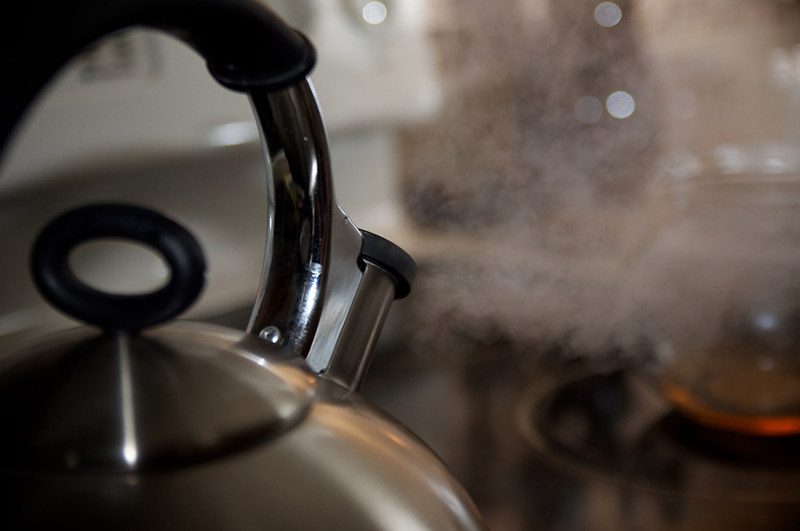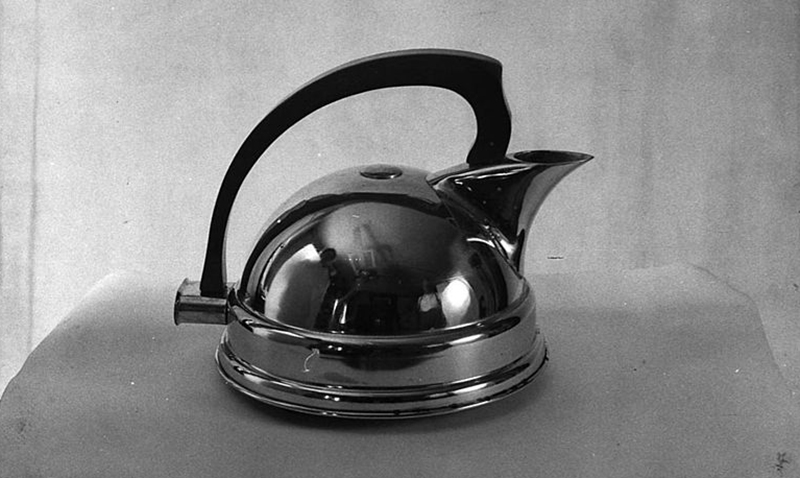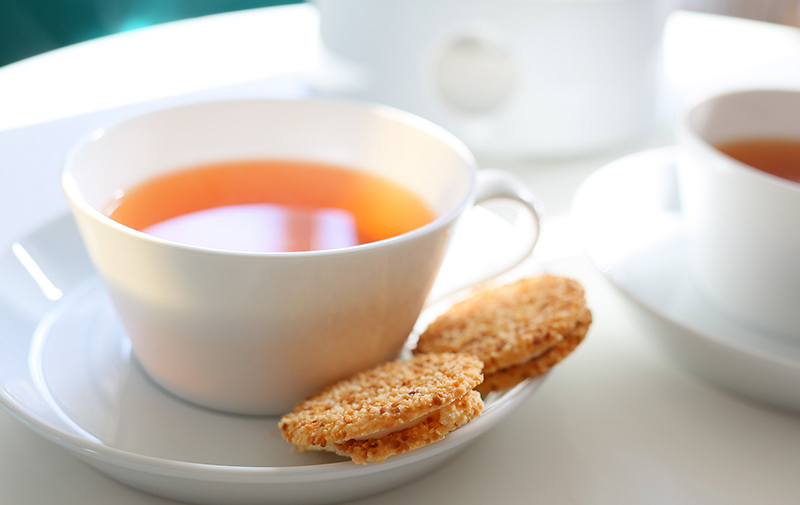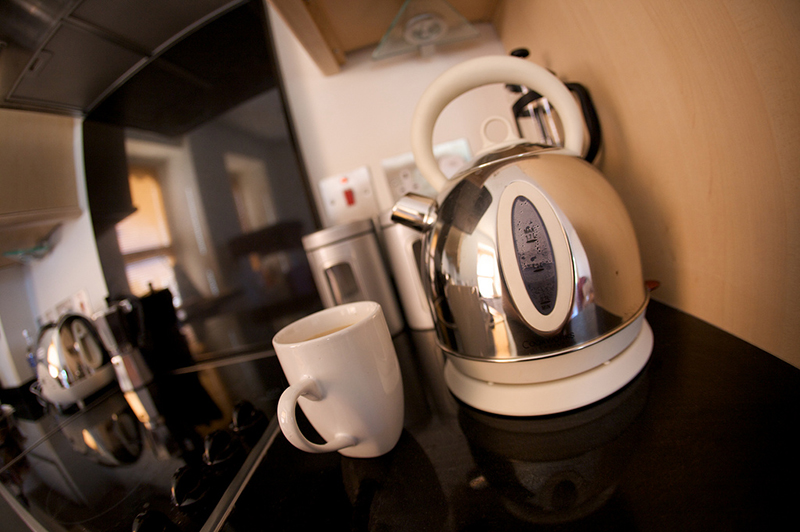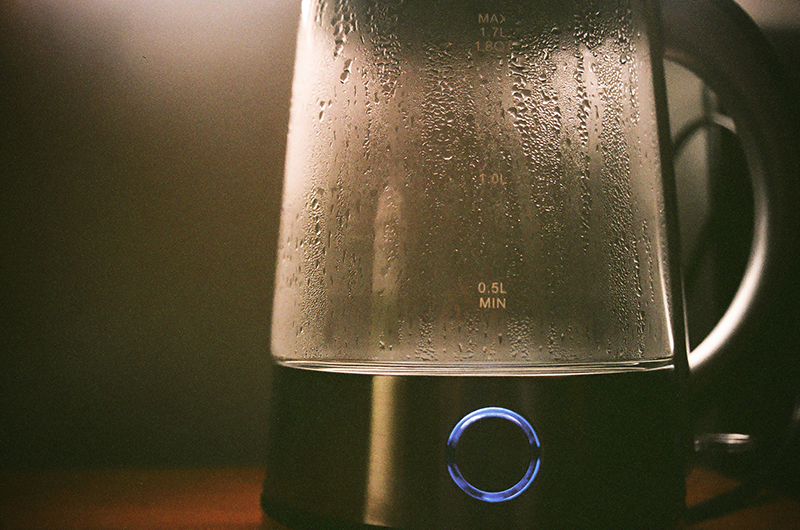When an anonymous tea drinker named comfortablynumb decided to buy a new electric kettle, he asked Chow Magazine’s community forum for help. He’d owned a Chantal kettle. He’d owned a Wolfgang Puck. Both had broken, with one rusting and the other chipping enough to send bits of lining into his tea cup, a process which mystified and irritated him. “I want a stainless kettle,” he told the forum, “and prefer it to not be made overseas.”
For the last eight months, comfortablynumb had been boiling water in a small German saucepan. 150 years after first harnessing electricity, was this what civilization had come to? Boiling water in a pan? For those of us fortunate enough to have enjoyed electric kettles, this anonymous poster’s process sounded tragic — a pitiful inconvenience on par with Homo erectus cracking open seed pods with stones in order to eat. Never mind that boiling water in pans is exactly what human beings had done for ages and that such simple measures had somehow, with the advent of convection ovens, crock pots, and the microwave, come to look primitive rather than timeless. What next, boiling water over a campfire?
According to the United Kingdom Tea Counsel, the British drink 165 million cups of tea every day, compared to their 70 million daily cups of coffee. That’s 60.2 billion cups per year, an average of three daily per person, making England the world’s second largest tea consumers per capita. Only the Republic of Ireland consumes more tea per capita. In 2003, tea composed around 42% of Great Britain’s fluid intake. Measured another way the British drink four point two pounds of tea per person, per year. The Irish drink four point eight pounds per person. The numbers start to numb my writer brain, but it’s clear: That’s a lot of tea. No surprise that the majority of them own an electric kettle.
No Brit or Irish citizen worth their salt would live life without one. “In the UK,” my American grad school classmate Marie said, “everyone and their mom had an electric kettle.”
“Everywhere I lived in England had one,” said my old coworker Megan, “and every house has one.” She returned to the US a convert and uses her stainless steel Oster 5965 one and a half liter single-temperature kettle every day.
One Glasgow resident I know called his electric kettle his “most indispensable possession.” “It would be really weird if someone didn’t have a kettle in the UK,” he said. “If not for folk’s own tea and hot water bottles, for guests.” Then a pause: “Is this not common in US?” Until 2012, I had never seen an electric kettle, and if I had, the memory didn’t stick. I certainly never used one to brew tea, and I drink a lot of tea. How could this be?
By comparison, the average American drinks 0.503 pounds of tea per year, and I imagine part of that is accidental, with tea somehow ending up in their mouths the way spiders inevitably end up in your food. Not me. I only drink tea. My writing life wouldn’t amount to much without green tea, and for that, I depend on an electric kettle.
I like caffeine. I like the ritual. And I love the taste of tea. Coffee smells incredible, but the taste doesn’t satisfy me like those sweet leaves, and I can’t drink cup after cup of coffee throughout the day the way I can tea. Coffee just doesn’t suit my metabolism. Naturally, tea has become an integral part of my daily writing routine.
The Chinese had been drinking it since at least 1121 BCE. If you believe the story of Emperor Shen Nong, as I do, then the Chinese discovered tea as far back as 2737 BCE, possibly earlier. The Dutch imported tea to Amsterdam in 1610. The English, a people indelibly linked with the beverage, only received their first tea shipment in 1645, and it came from the Dutch. When tea reached America in the mid-1600s, there was barely an America here. It was a land of countless First Nation peoples with their own hot beverages and culinary traditions. Tea fell out of favor with the new Americans after the Boston Tea Party, but socialites eventually picked the habit back up after the American Revolution, and tea consumption revived by the late-1800s. Tea came into my life around 1980. I was five. Unlike 1610, this date is approximate, but at some point during my childhood, my mother mixed Arizona clover honey into a mug of Celestial Seasonings’ Sleepytime herbal tea and everything changed.
Mom is a native New Yorker. Hers is a coffee-drinking city, filled with Dunkin Donuts and the sort of greasy late-night diners you associate with cheap coffee. Her family drank coffee, not tea, though her mom, my Grandma Silvia, always drank a mug of hot water with lemon with meals. No tea, no flavor, just water and a slice of lemon, and she didn’t always drink it. It often sat in front of her on the table like a garnish. Maybe it started there for me: the sight of a person’s hands wrapped around a tea cup, the pleasant clink of a spoon against porcelain. I still give the credit to my mom.
Few associate hot tea with Phoenix, Arizona, but the marriage of desert heat and sweet herbal concoction worked well. The flavor of chamomile flowers mixed with spearmint leaves and lemongrass made Sleepytime one of the most popular teas in the world, and it opened the gates for me. After that, I tried other herbal teas, called tisanes. During my undergrad years, I explored different greens and blacks. I dabbled with coffee for a bit but abandoned it because it abandoned me, leaving me sleepy halfway through my first morning class. After that, I got deep into oolongs and pu-erh teas, adding them to my very green and Darjeeling-heavy repertoire. Now I know that I prefer Kagoshima sencha to Shizuoka or Fukuoka senchas, that I prefer the stronger flavors of second flush Darjeelings to the lighter, greener first flush, and I know that Bai Hao oolongs suit fall and winter better than a Ti Kwan Yin, though sencha suits me better than all of them. So why did it take so long to get an electric kettle? Because I’m American.
For decades I used a standard stovetop kettle: You place it on the heated coils and wait for the whistle. I brewed so much tea that kettles broke regularly: handles melted, nozzles fell off, the metal charred when I accidentally heated them empty.
Where people in the UK probably can’t imagine a time when people boiled water in anything other than electric kettles, in the same way, modern Western teenagers can’t imagine an era that predated computers — yet such eras existed. You can read about them in books. And you can experience one of those sad eras first-hand right now in America, where the majority of citizens in this supposedly sophisticated, technologically advanced country somehow still use stovetop kettles to boil water for coffee and, occasionally, usually by accident, for tea. In fact, ask most Americans if they use electric kettles, and they’ll tell you what I would have told you four years ago: Electric wah?
Nine years before Bob Dylan went electric at the 1965 Newport Folk Festival, two enterprising Brits named Bill Russell and Peter Hobbs debuted the K1, the world’s first electric kettle. It sold like hot cakes, revolutionizing kettle design and changing the way people drink tea in Europe. Bold and cocky, yet short and sweet, the name K1 sounds like a Himalayan peak and suggests a watershed moment in the rugged expanse of consumer topography, a product from which all subsequent products would flow. The way history worked out, K1 does, in fact, function as a type of year zero, providing the hot beverage equivalent of the AD/BC moment to divide time into everything that came before or after. It was a rocky start.
Morphy Richards isn’t a person. It’s a British appliance manufacturer. Co-founded by Donal Morphy and Charles Richards in Kent, England in 1936, the company initially made its name by making electric irons. Appliances were still a luxury then, so the two enterprising men decided to capitalize on the market for affordable versions of certain practical items. They started making refrigerators and followed with spinning clothes dryers. Then electric toasters. Then large electric floor scrubbers, small hair dryers and space heaters, doing such brisk business by the second World War that they opened subsidiaries in South Africa, Australia, and Canada. A young engineer named Peter Hobbs managed the South Africa office in the early 1950s. Hobbs and Richards got into some sort of disagreement, so Hobbs quit and returned to England. He’d met another Morphy Richards employee in 1951, by the name of Major Bill Russell. As if to show that they made a great pair, Russell had some sort of disagreement with the company’s other namesake, Morphy, over who knows what. Russell also left. When he and Hobbs reconvened in England, they combined their sales and design knowledge with their knowledge of the marketplace and formed their own company, Russell Hobbs Ltd, in 1952. To my American ears, Russell Hobbs sounds like a digestive biscuit. It turned into a thriving business that exists to this day.
After the K1, Russell Hobbs launched the K2 in 1960, and it launched as many inspired impersonators as the Velvet Underground’s first record would launch copycat bands in 1967. While electric kettles are considered standard operating equipment there, I, on the other hand, had to work at a tea shop to learn about them. That’s how uncommon they are in America, though tea shops themselves are comparatively rare. It’s not that you don’t see electric kettles. Stores like Target, Sur La Table, and Macy’s sell them. It’s that you rarely see them in use. You don’t often go to a friend’s house and see them boil your coffee water in an electric kettle. Then again, rarely will a friend ask if you’d like a cup of tea rather than coffee. Requests for tea result in comments like, “I think I have some tea in there,” with them pointing to a drawer filled with disposable chopsticks and take-out menus. “I don’t know what there is, but there’s something.” They hand you old ginger tea. Old Stash Earl Gray. Bags of Bigelow peppermint so crumpled they seem to have been laundered in the same pants pockets that your friend stuffed them into when they stole them from a motel three years ago. When you brew their selection, the tea smells like the bay leaf and cumin they store in that drawer, and you use water heated on a stovetop kettle, not an electric. It’s disappointing. For a nation of gadget-freaks who watches America’s Test Kitchen, I don’t understand why we’re devoted to this 19th-century technology. We love the biggest and the best. We read kitchen catalogs like magazines and devour home design blogs. We invented obsolescence as a business model. What’s kept us from upgrading to an electric kettle? Why ignore their brushed steel charm for a primitive method dependent on coils? Electric kettles enable laziness, and laziness is our American birthright.
Why? The first reason: tea. We don’t drink enough of it for electronics to matter.
Second: appearances. A stovetop kettle looks more charming than an electric. One resembles a fusion reactor. the other signifies country charm and European civility.
Third: actually, one and two are it.
All of which is to say nothing really, other than thank goodness for Russell and Hobbs. I used to boil water on the stove. It took forever. Now I can hit a button and get back to writing. I need tea, but I don’t want to wait around all day for it. We can get to the moon. We should be able to heat water quickly.
I gave my stovetop kettle to Goodwill. When I write from home, I sit at a desk in our little corner office and the air fills with the sound of my Cuisinart CPK-17 variable temperature kettle drawing energy into the central coil. The low hiss of accumulating bubbles is soothing, like a peaceful brook. I can hear it from our bedroom on Sunday mornings, too when Rebekah and I sit in bed reading. Our greyhound snoozes on her dog bed. Outside, a construction crew cuts away strips of pavement to replace pipes. The neighbor kids ride bikes. Inside, the sound of the coil assures me that tea is always waiting. It uses 1500 watts of energy to heat one point seven ml of water, and it does so in minutes. Then it holds the temperate for half an hour.
“You are so happy with that thing,” Rebekah said weeks after she bought it for me for Christmas. I am. It’s the best kitchen appliance I’ve ever owned. If the cabinet full of sencha, Darjeeling, and assorted other teas wasn’t proof enough, the kettle is final proof that I am a tea nerd. I prefer not to write without one.
Hopefully, that Chowhound commenter has put down your Schulte-Ufer pan in favor of the Chef’s Choice brand variable temperature kettle which, as requested, is not made in China.
I might have drunk too much tea today because I’m sort of rambling on, aren’t I? Sorry about that. As they say in England, “I’ll put a kettle on.” Meaning, I’ll push this button. Every morning before I write, I push that button. •
Images courtesy of Vélocia, Wisconsin Department of Natural Resources, Joeri van Veen, Jago Pauwels, Imahinasyon Photography, 3rdCoastPhotography.net, Micheal Behrens, Paul Vallejo, independentyouth via Flickr (Creative Commons) and File Upload Bot (99of9) via Wikimedia Commons (Creative Commons).
